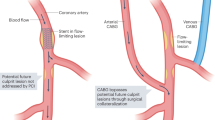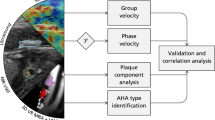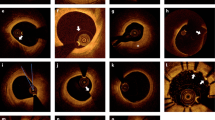Abstract
Advances in coronary imaging are needed to enable the early detection of plaque segments considered to be 'vulnerable' for causing clinical events. Pathological studies have contributed to our current understanding of these vulnerable or unstable segments of plaque. Intravascular ultrasonography (IVUS) has provided insights into the morphology of atherosclerosis, the mediators of plaque progression and the factors associated with acute coronary syndrome (ACS). In addition, the demonstration of pancoronary arterial instability has highlighted that ACS involves a multifocal disease process. Various second-generation intravascular imaging technologies—employing advanced processing of ultrasound radiofrequency backscatter signals, light-based imaging, spectroscopic imaging and molecular targeting—possess inherent advantages for the identification of meaningful surrogates of plaque instability. The fusion of these imaging technologies within a single imaging catheter is likely to allow for greater synergism in image quality and early disease detection. However, natural-history studies to validate the use of these novel imaging tools for enhanced risk prediction are needed before these strategies can be incorporated into mainstream clinical practice.
Key Points
-
Prevailing views of vulnerable atherosclerotic coronary plaque features are primarily based upon the 'plaque–rupture' hypothesis, which is predominantly derived from pathological observations at autopsy
-
Intravascular ultrasonography has demonstrated that acute and unstable coronary syndromes involve a multifocal process of pancoronary arterial instability with multiple plaque rupture and substantial atheroma burden
-
Second-generation intravascular imaging modalities employ ultrasound radiofrequency backscatter signal processing, light-based imaging, and spectroscopic imaging to enhance our imaging capabilities; however, each of these approaches requires further development and validation
-
Experimental models of atherosclerosis featuring plaque rupture will enhance our ability to image important mechanisms of plaque vulnerability, facilitating the development of novel antiatherosclerotic therapeutics and prognostic algorithms
This is a preview of subscription content, access via your institution
Access options
Subscribe to this journal
Receive 12 print issues and online access
$209.00 per year
only $17.42 per issue
Buy this article
- Purchase on Springer Link
- Instant access to full article PDF
Prices may be subject to local taxes which are calculated during checkout




Similar content being viewed by others
References
Herrick, J. B. Landmark article (JAMA 1912). Clinical features of sudden obstruction of the coronary arteries. By James B. Herrick. JAMA 250, 1757–1765 (1983).
Davies, M. J. & Thomas, A. Thrombosis and acute coronary-artery lesions in sudden cardiac ischemic death. N. Engl. J. Med. 310, 1137–1140 (1984).
DeWood, M. A. et al. Prevalence of total coronary occlusion during the early hours of transmural myocardial infarction. N. Engl. J. Med. 303, 897–902 (1980).
Ambrose, J. A. et al. Angiographic progression of coronary artery disease and the development of myocardial infarction. J. Am. Coll. Cardiol. 12, 56–62 (1988).
Glagov, S., Weisenberg, E., Zarins, C. K., Stankunavicius, R. & Kolettis, G. J. Compensatory enlargement of human atherosclerotic coronary arteries. N. Engl. J. Med. 316, 1371–1375 (1987).
Nicholls, S. J., Tuzcu, E. M., Sipahi, I., Schoenhagen, P. & Nissen, S. E. Intravascular ultrasound in cardiovascular medicine. Circulation 114, e55–e59 (2006).
Muller, J. E., Tofler, G. H. & Stone, P. H. Circadian variation and triggers of onset of acute cardiovascular disease. Circulation 79, 733–743 (1989).
Finn, A. V., Nakano, M., Narula, J., Kolodgie, F. D. & Virmani, R. Concept of vulnerable/unstable plaque. Arterioscler. Thromb. Vasc. Biol. 30, 1282–1292 (2010).
Burke, A. P. et al. Coronary risk factors and plaque morphology in men with coronary disease who died suddenly. N. Engl. J. Med. 336, 1276–1282 (1997).
Rioufol, G. et al. Multiple atherosclerotic plaque rupture in acute coronary syndrome: a three-vessel intravascular ultrasound study. Circulation 106, 804–808 (2002).
Hong, M. K. et al. Comparison of coronary plaque rupture between stable angina and acute myocardial infarction: a three-vessel intravascular ultrasound study in 235 patients. Circulation 110, 928–933 (2004).
Mintz, G. S. et al. Atherosclerosis in angiographically “normal” coronary artery reference segments: an intravascular ultrasound study with clinical correlations. J. Am. Coll. Cardiol. 25, 1479–1485 (1995).
Porter, T. R. et al. Intravascular ultrasound study of angiographically mildly diseased coronary arteries. J. Am. Coll. Cardiol. 22, 1858–1865 (1993).
Schoenhagen, P., Ziada, K. M., Vince, D. G., Nissen, S. E. & Tuzcu, E. M. Arterial remodeling and coronary artery disease: the concept of “dilated” versus “obstructive” coronary atherosclerosis. J. Am. Coll. Cardiol. 38, 297–306 (2001).
Smits, P. C., Pasterkamp G., de Jaegere P. P., de Feyter, P. J. & Borst, C. Angioscopic complex lesions are predominantly compensatory enlarged: an angioscopy and intracoronary ultrasound study. Cardiovasc. Res. 41, 458–464 (1999).
Varnava, A. M., Mills, P. G. & Davies, M. J. Relationship between coronary artery remodeling and plaque vulnerability. Circulation 105, 939–943 (2002).
Schoenhagen, P. et al. Extent and direction of arterial remodeling in stable versus unstable coronary syndromes. An intravascular ultrasound study. Circulation 101, 598–603 (2000).
Naghavi, M. et al. From vulnerable plaque to vulnerable patient: a call for new definitions and risk assessment strategies: Part I. Circulation 108, 1664–1672 (2003).
Maehara, A. et al. Morphologic and angiographic features of coronary plaque rupture detected by intravascular ultrasound. J. Am. Coll. Cardiol. 40, 904–910 (2002).
Jeremias, A. et al. Coronary artery compliance and adaptive vessel remodelling in patients with stable and unstable coronary artery disease. Heart 84, 314–319 (2000).
Takano, M. et al. Mechanical and structural characteristics of vulnerable plaques: analysis by coronary angioscopy and intravascular ultrasound. J. Am. Coll. Cardiol. 38, 99–104 (2001).
Fujii, K. et al. Intravascular ultrasound assessment of ulcerated ruptured plaques: a comparison of culprit and nonculprit lesions of patients with acute coronary syndromes and lesions in patients without acute coronary syndromes. Circulation 108, 2473–2478 (2003).
Fujii, K. et al. Intravascular ultrasound profile analysis of ruptured coronary plaques. Am. J. Cardiol. 98, 429–435 (2006).
Schartl, M. et al. Use of intravascular ultrasound to compare effects of different strategies of lipid-lowering therapy on plaque volume and composition in patients with coronary artery disease. Circulation 104, 387–392 (2001).
Tardif, J. C. et al. Effects of reconstituted high-density lipoprotein infusions on coronary atherosclerosis: a randomized controlled trial. JAMA 297, 1675–1682 (2007).
Nair, A., Kuban, B. D., Obuchowski, N. & Vince, D. G. Assessing spectral algorithms to predict atherosclerotic plaque composition with normalized and raw intravascular ultrasound data. Ultrasound Med. Biol. 27, 1319–1331 (2001).
Nair, A. et al. Coronary plaque classification with intravascular ultrasound radiofrequency data analysis. Circulation 106, 2200–2206 (2002).
Nair, A., Margolis, M. P., Kuban, B. D. & Vince, D. G. Automated coronary plaque characterisation with intravascular ultrasound backscatter: ex vivo validation. EuroIntervention 3, 113–120 (2007).
Wickline, S. A. et al. Beyond intravascular imaging: quantitative ultrasonic tissue characterization of vascular pathology. IEEE Ultrasonics Symp. 3, 1589–1597 (1994).
Okubo, M. et al. Tissue characterization of coronary plaques: comparison of integrated backscatter intravascular ultrasound with virtual histology intravascular ultrasound. Circ. J. 72, 1631–1639 (2008).
Kawasaki, M. et al. Noninvasive quantitative tissue characterization and two-dimensional color-coded map of human atherosclerotic lesions using ultrasound integrated backscatter: comparison between histology and integrated backscatter images. J. Am. Coll. Cardiol. 38, 486–492 (2001).
Sathyanarayana, S., Carlier, S., Li, W. & Thomas, L. Characterisation of atherosclerotic plaque by spectral similarity of radiofrequency intravascular ultrasound signals. EuroIntervention 5, 133–139 (2009).
Rodriguez-Granillo, G. A. et al. In vivo intravascular ultrasound-derived thin-cap fibroatheroma detection using ultrasound radiofrequency data analysis. J. Am. Coll. Cardiol. 46, 2038–2042 (2005).
Hong, M. K. et al. A three-vessel virtual histology intravascular ultrasound analysis of frequency and distribution of thin-cap fibroatheromas in patients with acute coronary syndrome or stable angina pectoris. Am. J. Cardiol. 101, 568–572 (2008).
Kubo, T. et al. The dynamic nature of coronary artery lesion morphology assessed by serial virtual histology intravascular ultrasound tissue characterization. J. Am. Coll. Cardiol. 55, 1590–1597 (2010).
Stone, G. W. Providing regional observation to study predictors of events in the coronary tree—the PROSPECT trial. Presented at the Transcatheter Cardiovascular Therapeutics conference (San Fransisco, 2009).
de Korte, C. L., van der Steen, A. F., Céspedes, E. I. & Pasterkamp, G. Intravascular ultrasound elastography in human arteries: initial experience in vitro. Ultrasound Med. Biol. 24, 401–408 (1998).
Van Mieghem, C. A. et al. Noninvasive detection of subclinical coronary atherosclerosis coupled with assessment of changes in plaque characteristics using novel invasive imaging modalities: the Integrated Biomarker and Imaging Study (IBIS). J. Am. Coll. Cardiol. 47, 1134–1142 (2006).
Schaar, J. A. et al. Incidence of high-strain patterns in human coronary arteries: assessment with three-dimensional intravascular palpography and correlation with clinical presentation. Circulation 109, 2716–2719 (2004).
Serruys, P. W. et al. Effects of the direct lipoprotein-associated phospholipase A(2) inhibitor darapladib on human coronary atherosclerotic plaque. Circulation 118, 1172–1182 (2008).
Thim, T. et al. Unreliable assessment of necrotic core by virtual histology intravascular ultrasound in porcine coronary artery disease. Circ. Cardiovasc. Imaging 3, 384–391 (2010).
Kubo, T. et al. Assessment of culprit lesion morphology in acute myocardial infarction: ability of optical coherence tomography compared with intravascular ultrasound and coronary angioscopy. J. Am. Coll. Cardiol. 50, 933–939 (2007).
Cassis, L. A. & Lodder, R. A. Near-IR imaging of atheromas in living arterial tissue. Anal. Chem. 65, 1247–1256 (1993).
Jaross, W., Neumeister, V., Lattke, P. & Schuh, D. Determination of cholesterol in atherosclerotic plaques using near infrared diffuse reflection spectroscopy. Atherosclerosis 147, 327–337 (1999).
Gardner, C. M. et al. Detection of lipid core coronary plaques in autopsy specimens with a novel catheter-based near-infrared spectroscopy system. JACC Cardiovasc. Imaging 1, 638–648 (2008).
Waxman, S. et al. In vivo validation of a catheter-based near-infrared spectroscopy system for detection of lipid core coronary plaques: initial results of the SPECTACL study. JACC Cardiovasc. Imaging 2, 858–868 (2009).
ClinicalTrials.gov. Study of near infrared spectroscopy (NIRS) and intravascular ultrasound (IVUS) combination coronary catheter (SAVOIR) [online], (2010).
Bruggink, J. L. et al. Spectroscopy to improve identification of vulnerable plaques in cardiovascular disease. Int. J. Cardiovasc. Imaging 26, 111–119 (2010).
Nazemi, J. H. & Brennan, J. F. Lipid concentrations in human coronary artery determined with high wavenumber Raman shifted light. J. Biomed. Opt. 14, 034009 (2009).
Römer, T. J., et al. Intravascular ultrasound combined with Raman spectroscopy to localize and quantify cholesterol and calcium salts in atherosclerotic coronary arteries. Arterioscler. Thromb. Vasc. Biol. 20, 478–483 (2000).
Buschman, H. P. et al. Diagnosis of human coronary atherosclerosis by morphology-based Raman spectroscopy. Cardiovasc. Pathol. 10, 59–68 (2001).
Prati, F. et al. Expert review document on methodology, terminology, and clinical applications of optical coherence tomography: physical principles, methodology of image acquisition, and clinical application for assessment of coronary arteries and atherosclerosis. Eur. Heart J. 31, 401–415 (2010).
Prati, F. et al. Safety and feasibility of a new non-occlusive technique for facilitated intracoronary optical coherence tomography (OCT) acquisition in various clinical and anatomical scenarios. EuroIntervention 3, 365–370 (2007).
Serruys, P. W. et al. A bioabsorbable everolimus-eluting coronary stent system (ABSORB): 2-year outcomes and results from multiple imaging methods. Lancet 373, 897–910 (2009).
Cook, S. et al. Incomplete stent apposition and very late stent thrombosis after drug-eluting stent implantation. Circulation 115, 2426–2434 (2007).
Finn, A. V. et al. Pathological correlates of late drug-eluting stent thrombosis: strut coverage as a marker of endothelialization. Circulation 115, 2435–2441 (2007).
Joner, M. et al. Pathology of drug-eluting stents in humans: delayed healing and late thrombotic risk. J. Am. Coll. Cardiol. 48, 193–202 (2006).
Jang, I. K. et al. In vivo characterization of coronary atherosclerotic plaque by use of optical coherence tomography. Circulation 111, 1551–1555 (2005).
Kubo, T. et al. Multiple coronary lesion instability in patients with acute myocardial infarction as determined by optical coherence tomography. Am. J. Cardiol. 105, 318–322 (2010).
MacNeill, B. D. et al. Focal and multi-focal plaque macrophage distributions in patients with acute and stable presentations of coronary artery disease. J. Am. Coll. Cardiol. 44, 972–979 (2004).
Raffel, O. C. et al. Relationship between a systemic inflammatory marker, plaque inflammation, and plaque characteristics determined by intravascular optical coherence tomography. Arterioscler. Thromb. Vasc. Biol. 27, 1820–1827 (2007).
Li, Q. X. et al. Relationship between plasma inflammatory markers and plaque fibrous cap thickness determined by intravascular optical coherence tomography. Heart 96, 196–201 (2010).
Tanaka, A. et al. Morphology of exertion-triggered plaque rupture in patients with acute coronary syndrome: an optical coherence tomography study. Circulation 118, 2368–2373 (2008).
Kawasaki, M. et al. Diagnostic accuracy of optical coherence tomography and integrated backscatter intravascular ultrasound images for tissue characterization of human coronary plaques. J. Am. Coll. Cardiol. 48, 81–88 (2006).
Manfrini, O. et al. Sources of error and interpretation of plaque morphology by optical coherence tomography. Am. J. Cardiol. 98, 156–159 (2006).
Yuan, S. et al. Co-registered optical coherence tomography and fluorescence molecular imaging for simultaneous morphological and molecular imaging. Phys. Med. Biol. 55, 191–206 (2010).
Li, X. et al. High-resolution coregistered intravascular imaging with integrated ultrasound and optical coherence tomography probe. Appl. Phys. Lett. 97, 133702 (2010).
Slager, C. J. et al. True 3-dimensional reconstruction of coronary arteries in patients by fusion of angiography and IVUS (ANGUS) and its quantitative validation. Circulation 102, 511–516 (2000).
Krams, R. et al. Evaluation of endothelial shear stress and 3D geometry as factors determining the development of atherosclerosis and remodeling in human coronary arteries in vivo. Combining 3D reconstruction from angiography and IVUS (ANGUS) with computational fluid dynamics. Arterioscler. Thromb. Vasc. Biol. 17, 2061–2065 (1997).
Coskun, A. U. et al. Reproducibility of coronary lumen, plaque, and vessel wall reconstruction and of endothelial shear stress measurements in vivo in humans. Catheter Cardiovasc. Interv. 60, 67–78 (2003).
Gibson, C. M. et al. Relation of vessel wall shear stress to atherosclerosis progression in human coronary arteries. Arterioscler. Thromb. 13, 310–315 (1993).
Koskinas, K. C. et al. Natural history of experimental coronary atherosclerosis and vascular remodeling in relation to endothelial shear stress: a serial, in vivo intravascular ultrasound study. Circulation 121, 2092–2101 (2010).
Kolodgie, F. D. et al. Intraplaque hemorrhage and progression of coronary atheroma. N. Engl. J. Med. 349, 2316–2325 (2003).
Vavuranakis, M. et al. A new method for assessment of plaque vulnerability based on vasa vasorum imaging, by using contrast-enhanced intravascular ultrasound and differential image analysis. Int. J. Cardiol. 130, 23–29 (2008).
Goertz, D. E. et al. Subharmonic contrast intravascular ultrasound for vasa vasorum imaging. Ultrasound Med. Biol. 33, 1859–1872 (2007).
Kaufmann, B. A. Ultrasound molecular imaging of atherosclerosis. Cardiovasc. Res. 83, 617–625 (2009).
Lindner, J. R. Contrast ultrasound molecular imaging: harnessing the power of bubbles. Cardiovasc. Res. 83, 615–616 (2009).
Acknowledgements
R. Puri is supported by a Postgraduate Medical Research Scholarship issued jointly from the National Health & Medical Research Council (565579) and the National Heart Foundation of Australia (PC0804045), and a Dawes Scholarship, Hanson Institute. M. I. Worthley is a SA Health Early-to-Mid-Career Practitioner Fellow.
Author information
Authors and Affiliations
Contributions
R. Puri researched the data for the article and wrote the article. All authors provided a substantial contribution to discussions of the content and to the review and/or editing of the manuscript before submission.
Corresponding author
Ethics declarations
Competing interests
S. J. Nicholls is a consultant and on the speaker's bureau for Astrazeneca and Roche. He also receives grant/research support from Astrazeneca, Novartis and Resverlogix. R. Puri and M. I. Worthley declare no competing interests.
Rights and permissions
About this article
Cite this article
Puri, R., Worthley, M. & Nicholls, S. Intravascular imaging of vulnerable coronary plaque: current and future concepts. Nat Rev Cardiol 8, 131–139 (2011). https://doi.org/10.1038/nrcardio.2010.210
Published:
Issue Date:
DOI: https://doi.org/10.1038/nrcardio.2010.210
This article is cited by
-
Revolutionizing medical imaging: a comprehensive review of optical coherence tomography (OCT)
Journal of Optics (2024)
-
Intravascular polarization-sensitive optical coherence tomography based on polarization mode delay
Scientific Reports (2022)
-
Plaque erosion and acute coronary syndromes: phenotype, molecular characteristics and future directions
Nature Reviews Cardiology (2021)
-
Artificial Intelligence in Intracoronary Imaging
Current Cardiology Reports (2020)
-
All-Optical Rotational Ultrasound Imaging
Scientific Reports (2019)



